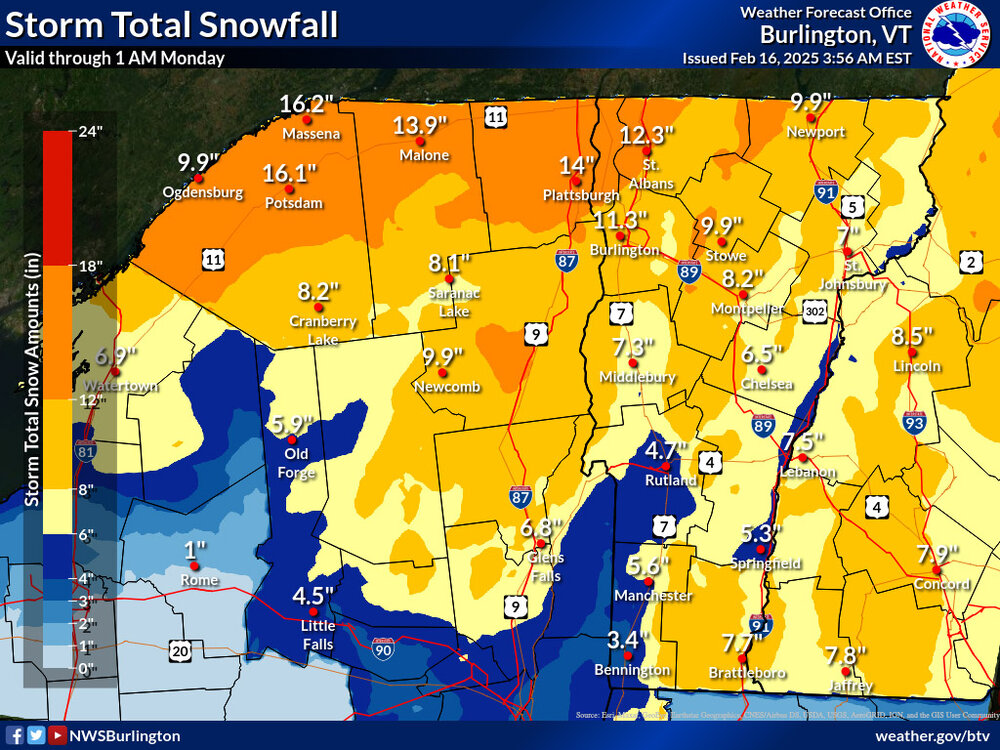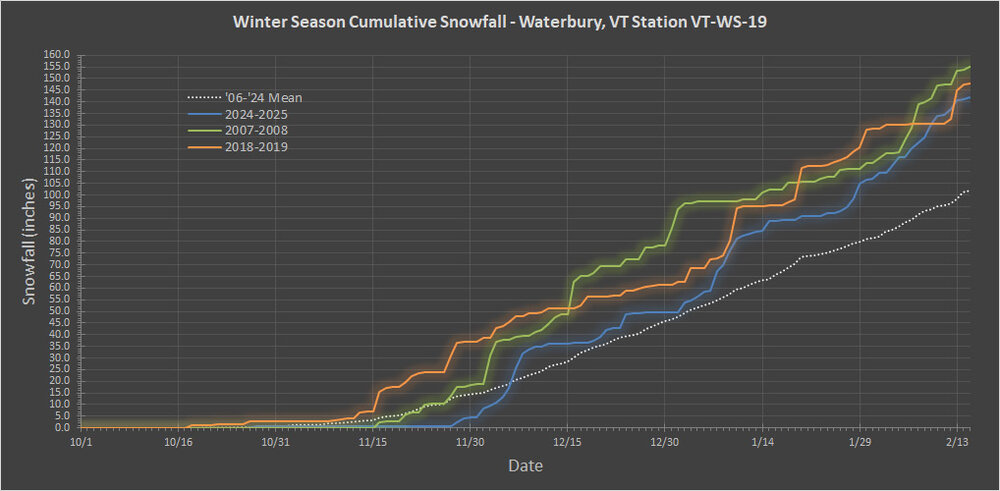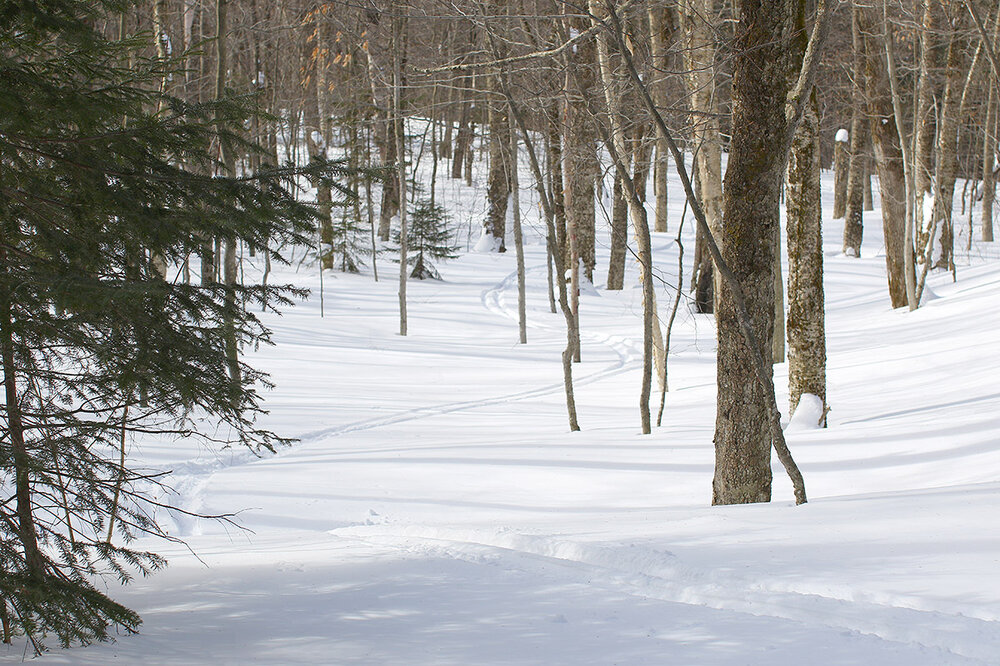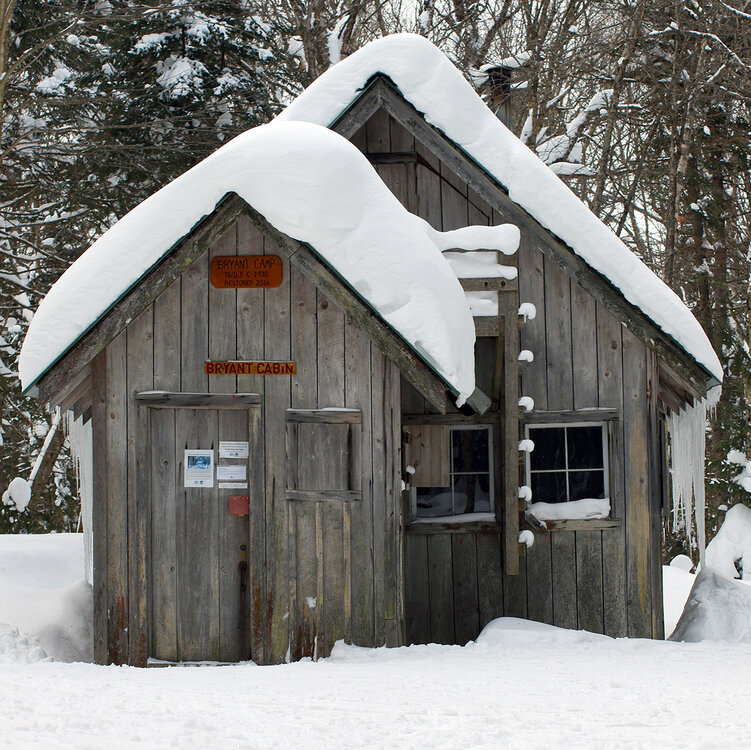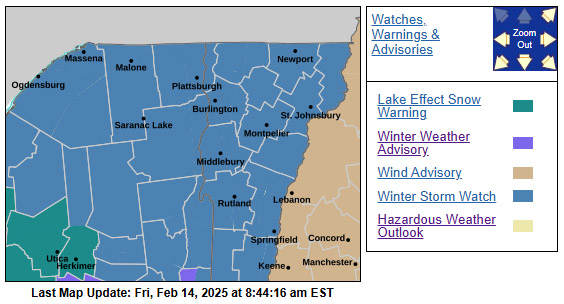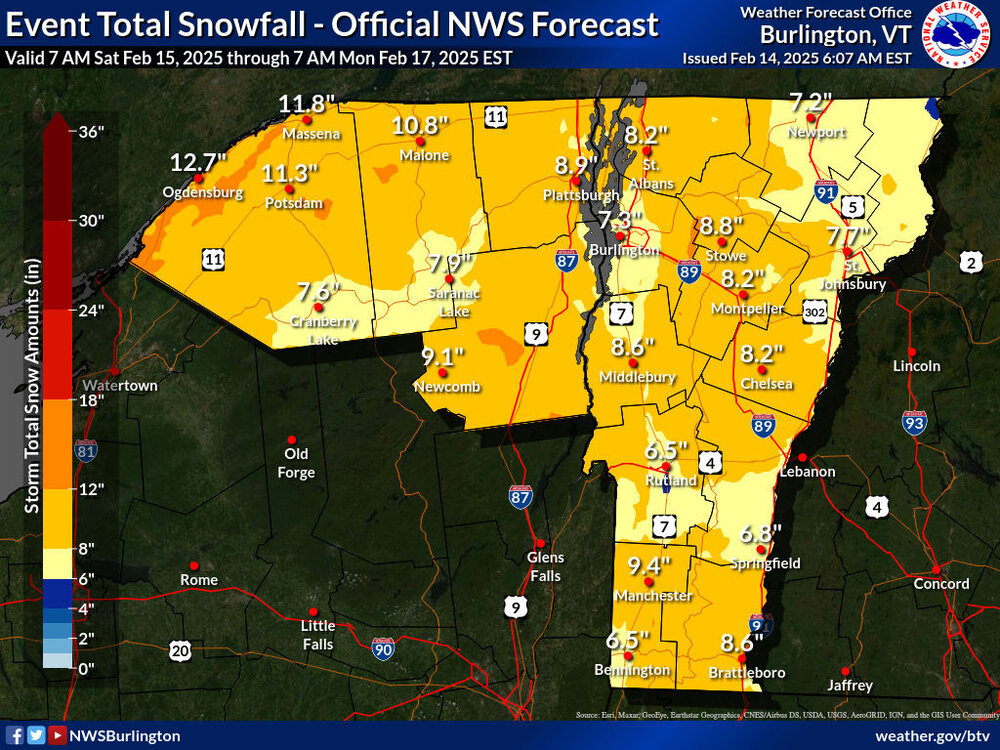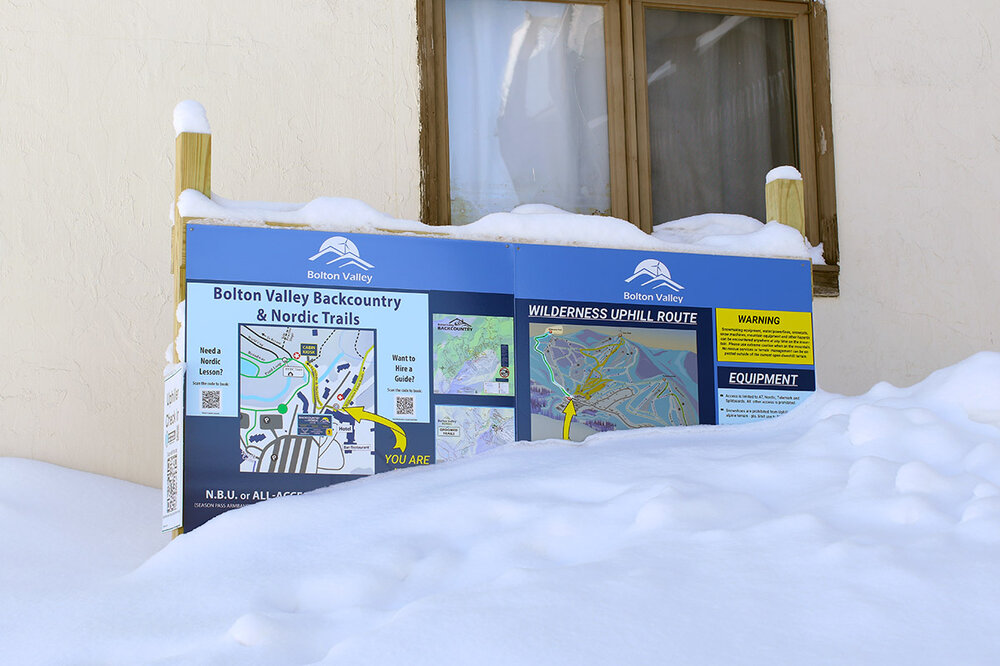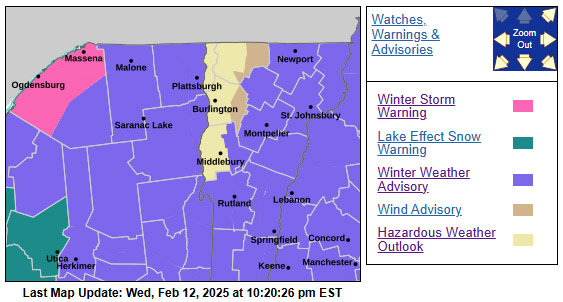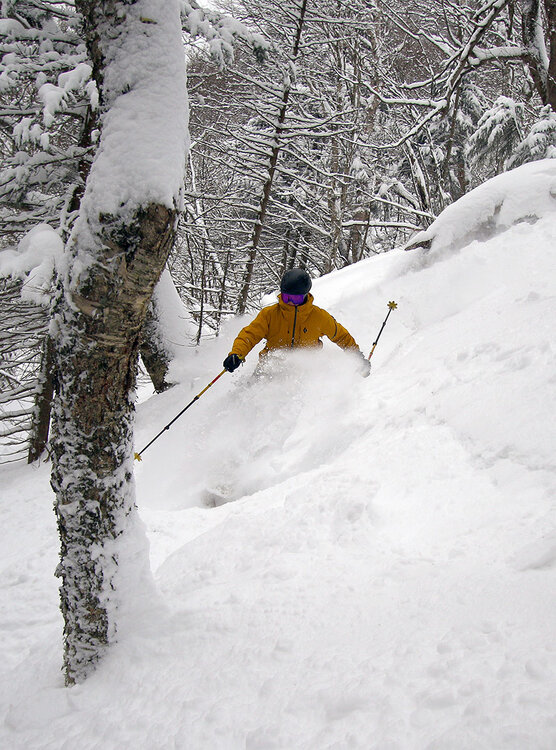-
Posts
6,317 -
Joined
-
Last visited
Content Type
Profiles
Blogs
Forums
American Weather
Media Demo
Store
Gallery
Everything posted by J.Spin
-
I was out a little while ago for observations, and we were getting 2”/hr. snow, and from what I’ve seen, this is the most intense snowfall from this system thus far. With this evening’s snows it looks like this season’s snowfall progress has actually jumped a bit ahead of the 2007-2008 season.
-
Aside from the change to Winter Storm Warnings, there hasn’t been too much to update with respect to the BTV NWS maps for this event – the most recent Storm Total Snowfall maps with the general 8-12” shading have been he way to go. There was a bit of a bump with this morning’s map update though, which returned some of the 12-18” shading along the spine in the Bolton Valley to Stowe stretch.
-
I see that Ginx has popped into the NNE thread with a couple of updates on the season, and we’ve hit midmonth now, so it’s probably a good time for the seasonal snowfall progression update from our site anyway. I saw the reference to the 2007-2008 season in his first post, and indeed that was a solid, 200”+ season down here in the valley. We haven’t been running with the 2007-2008 pace (green line in the plots below) so far this season, but we’ve been getting a bit closer as of February. Looking at the season as a whole, it really comes down to November: the 2007-2008 season had a decent November with roughly 20 inches of snow, but this season we had a below average November with only 4 inches of snow. Were it not for that slow start, this season would actually be running right up there with 2007-2008. Another decent season that’s getting some mention is 2018-2019 because Matt Parilla has recently updated his website to provide the cool parameter of “Last Snowier Winter”, so I’ve added the 2018-2019 data as the orange line in the plots below. The 2018-2019 season doesn’t come to mind quite as quickly as 2007-2008 does (it didn’t quite break 200” here in the valley), but it was clearly solid with respect to snowfall if it’s running in the neighborhood of 2007-2008. We’re still behind the snowfall pace of 2018-2019 at this point, but we’re in the midst of Winter Storm Jett hitting us with some decent accumulations, so this season may make up a bit of ground in the coming days The first plot below covers snowfall up through Feb 15 for a closer look at where we’ve been comparatively among the three seasons, and then the second plot goes out through the end of March for a look ahead at how the 2007-2008 and 2018-2019 seasons progressed over the next month or two. One can clearly see from the plots how this season started out well behind the other two, but it also speaks to the strong pace of snowfall we’ve seen over the past couple of months to be able to gain ground on those seasons, where Mother Nature really didn’t take her foot off the snowfall pedal.
-
I hadn’t been up to the mountain since Wednesday, so I was eager to see how the ski conditions were faring as we move into the weekend. Winter Storm Iliana had hit the area at the end of the week, and while I didn’t see any mixed precipitation at our house near the Waterbury/Bolton line, I’d heard reports that the system had brought mixed precipitation to some areas. Overall though, snowfall has certainly continued to roll on at a solid Northern Greens pace in recent days – the Bolton Valley snow report was indicating 34 inches of snow in the past week. It’s the President’s Day holiday weekend, so the potential is there for a lot of visitors at the local resorts. We also have another large system (Winter Storm Jett) coming into the area this evening, and it should be hanging around through the rest of the weekend. I’m not sure how that plays into the plans of folks who are visiting the area for skiing, but I figured I’d just pop out for a relatively short ski tour in the Bryant Cabin area today. I headed up to Bolton around midmorning, and there were no signs posted at Timberline about the upper parking areas being full. There were also plenty of available parking spaces when I got up to the Village, and I actually was able to park in the closest spot to the Broadway Trail in the backcountry lot. The lower section of the Bryant Trail had been freshly groomed, and they’d done a serious grooming – the groomed area was so wide that it could easily support two-way traffic for automobiles. Temperatures were in the teens F and there was some sun mixed with clouds, so it ended up being quite comfortable. I toured up and around Bryant Cabin to the Not a Trail traverse, and then made my way down into Gotham City. Skier traffic wasn’t bad at all – a few of the most convenient Bryant Trail glades like JJ’s, and Big Blue had seen some decent skier traffic, but most glades had seen little to no activity at that point. I had first tracks down through the Grizzwall and Gun Sight glades. After my tour I stopped in at the new Nordic and Backcountry Center by the Village Circle to check it out and grab a couple of maps. Speaking with some of the associates, they said it had been busy in the early morning when people were stopping in and renting backcountry gear, but it was relatively quiet when I was there around midday. I also took a quick tour around the Village for some photography, and there weren’t any life queues at the lifts that I saw, so I think the fact that it’s a blackout period for some types of resort passes was helping to keep the number of visitors in check. Even when I was leaving the resort around midday there were still no signs at Timberline indicating that the upper parking lots were full, so that was another sign that visitation wasn’t hitting the packed levels that it does on some weekends. I’d started checking the consistency and depths of the snowpack right from the start of my tour, since I was curious if there had been any mixed precipitation over the past couple of days. I didn’t find evidence of any firm layers in the snowpack, so if they picked up any mixed precipitation on the mountain, it must have been extremely minimal. The uppermost layers of powder in the snowpack certainly weren’t of champagne consistency, and that made sense based on my liquid analyses of Winter Storm Iliana from down at the house. The storm brough 0.40 inches of liquid to our site in the valley, and the snow density for the storm came in at exactly 10% H2O. So, it was a very synoptic-like medium density snow that was topping the snowpack. Thankfully, it skied great, and there wasn’t any upside-down feeling to the powder atop the snowpack. I could cut nice deep turns into the powder on steep terrain with no issues. I toured in the 2,000’ to 2,700’ elevation range today, and powder depths were typically anywhere from 30 inches on the low end to 40+ “swallow-your-entire-ski-pole” inches before I’d hit a substantially firm layer. I could find spots where there was detectable wind slab about a foot down, but in the sheltered areas of the backcountry network where I was touring, those were generally few and far between. The overall snowpack depth at 3,700’ the Mt. Mansfield Stake is 85 inches as of today’s update, and snowpack in the 2,000’-2,700’ range I toured today was clearly at least 30 to 40 inches deep, since I wasn’t necessarily reaching ground level in my depth checks. Like Wednesday, I was again finding extra “unexpected” lines opening up as lower vegetation becomes completely buried. And, right now we have Winter Storm Jett hitting the area with another 6 to 12 inches of snow expected, so we should be adding another significant bump to the snowpack in terms of both depth and liquid equivalent.
-
I received a text alert this morning that we’ve been put under a Winter Storm Watch, which in association with Winter Storm Jett that is currently crossing the country. The latest BTV NWS maps are below, and on the Event Total Snowfall map they currently have some of the 12-18” shading here along the spine in the Bolton Valley to Stowe stretch of the Northern Greens. I see mreaves also recently posted a copy of the preliminary map above as well.
-
On Tuesday I headed home from Burlington at the end of the day amidst heavy snow that was falling at an inch per hour or more. The roads weren’t horrible, but the low visibility made driving really tough, at least through to the Williston area. In an exact reversal of the usual geographic snowfall trends we see here in the Northern Greens, the snow intensity lightened up the farther I headed into the mountains, and there was only light snow falling at home on the Waterbury/Bolton line. I checked the radar to see what was up, and there was an interesting band of snow aligned east to west stretching out from the Burlington area. We were just on the southern edge of that band here in the Winooski Valley, which is why the snowfall was lighter. As the band sank southward a bit more though, the snowfall intensity increased, and by morning we’d picked up 3.1 inches of snow here at the house, with Bolton Valley reporting 4 inches of new snow. The addition of the new snow was intriguing enough to get me to head up to the mountain for a quick morning ski tour using the Wilderness Uphill Route. Temperatures up at the resort were in the teens F, and with solid sunshine, it was a welcomed change from touring in the single digits F. There were no concerns about the new snow messing with the existing powder density gradient because the added snow was incredibly dry – my liquid analyses from down at the house indicated that the snow density came in around 2% H2O. A modest amount of snow that dry certainly doesn’t provide a resurfacing, but with plenty of deep powder already available off piste, and excellent subsurfaces on piste, it was plenty of snow to serve as icing on the cake and make the turns really effortless on any pitch. The snow from this localized band was just another small addition to the healthy midwinter snowpack in the Northern Greens, but all these events keep adding up - the depth at the Mt. Mansfield Stake is currently at 82 inches, which is between 7 and 8 feet. The healthy snowpack depth is becoming noticeable because more and more of the off-piste underbrush is disappearing, and on this tour, I started to notice lines opening up that I’m not too familiar with. Some of these novel ski lines are due to the extensive work that Bolton Valley has done on their mountain bike trails, but some are indeed arising from the fact that the mountain snowpack is simply getting deep enough to bury a lot of vegetation. We’re currently in the midst of Winter Storm Iliana, which will likely change the composition of the snowpack again. I haven’t seen any sort of mixed precipitation in this area, but snow analyses here in the valley have revealed snow densities anywhere from 7 to 13% H2O, so there is some denser snow in there. The composition of the snowpack will probably change yet again heading into the weekend – the forecast suggests that Winter Storm Jett will affect the area with potentially a foot of snow or more in the mountains, but we still have a couple of days to see how that system plays out.
-
We’re under a Winter Weather Advisory for the next system coming into the area (Winter Storm Iliana), with snow accumulations along the spine of the Greens in this area topping out around 4 to 6 inches. The latest BTV NWS maps are below:
-
Hey, every part of the globe deals with climate change differently. As they say, it’s just something you’re going to have to get used to going forward. So… “Deal with it.”, I guess?
-
Yesterday I headed up to Bolton Valley with my younger son and some of his friends to ski the accumulations from Winter Storm Garnett. The resort was reporting 8 inches of new snow from the system as of their morning update, so on top of the accumulations that we’ve been getting from the parade of small and moderate storms over the last several weeks, it was just another layer of frosting on the cake. Down in the valley we’d picked up 0.40 inches of liquid equivalent from the storm at that point, so the upper elevations of the resort should have picked up at least a half inch of liquid. That’s a moderate resurfacing of the slopes, but the quality of the subsurface snow is so high at this point, that even a half inch of liquid equivalent sets up some fantastic skiing. The depth of the snowpack at the Mt. Mansfield Stake is now 84 inches, or put another way, the snow is 7 feet deep, so more and more steep slopes and ledges are coming into play every day. Another important aspect of Winter Storm Garnett was that it came without much wind at all, so that has finally allowed some of the wind-scoured western facing pitches at Bolton to start building some snowpack. In practical ski terms, the state of the snowpack plus the new snow let us focus on a “steep and deep” day, hitting areas like Devil’s Playground, some of the chutes off Upper Crossover, and various other places. The heavily scoured steep areas definitely need a few more moderate storms, or perhaps a big system with easterly instead of westerly flow to acquire a deep base, but a lot of steep, fun terrain is already in play.
-
The shortwave that hit the area overnight sort of felt like it came out of nowhere, but the snow cranked up enough to deliver a half foot across the Northern Greens, and it was still falling early this morning. As the morning progressed though, the snowfall eventually subsided, and the sun came out to give us a nice window of pleasant weather between systems. The sun helped bring the temperatures up around 20 F at the mountain today – I definitely felt that warmth down at the Timberline Base at 1,500’, but up above 3,000’ along the ridgelines, it was still well below 20 F, and the sunshine could only do so much. The overnight snow made conditions at the resort even better than what I’d experienced yesterday. The rapid-fire storms that keep coming through just sort of blend together, but Bolton Valley is reporting 2 to 3 feet of new snow in the past week, and that snowfall is constantly refreshing the on-piste surfaces and the off-piste powder. My younger son was up at the mountain with a group of about 10 friends today, so I joined them for a bit and enjoyed some of the especially good conditions on Wilderness since the lift has recently been down for mechanical work. The Vista Quad was down for a couple of periods today for mechanical issues of its own, so Wilderness would develop a lift queue during those periods, and the Timberline Quad would as well to a lesser extent. The Vista Quad eventually looked like it was running again, so hopefully they’ve taken care of whatever mechanical issue popped up. The next system in the storm parade is Winter Storm Garnett, which looks to bring 4 to 8 inches of new snow to the mountains by tomorrow. The snow from Garnett has already started falling here at our house in Waterbury, so hopefully there will be a nice fresh coating of powder to kick things off at the mountain in the morning.
-
I received a text early this morning that we’d been put under a Winter Weather Advisory for the system expected to come into the area this evening (Winter Storm Garnett). The point forecast around here suggests accumulations in the 4-9” range, which is in line with the northern areas of the yellow 6-8” shading on the Event Total Snowfall map.
-
That just kept rolling along all night – at observations time this morning it was light snow with fairly large flakes up to 15 mm here at our place. In their forecast discussion, the BTV NWS says it’s shortwave energy with a pocket of mid-level moisture and northwest flow.
-
I didn’t have time to get out for turns this morning, so on the way home from Burlington I headed up for some afternoon/evening skiing at Bolton Valley to check out what the new snow had done for the slopes. I hadn’t been up to the mountain since Wednesday, so that mean all the snow from Winter Storm Freya yesterday, including the intense backside squalls this morning, had recently been added. It often gets cold quickly as the sun goes down, but with temperatures in the upper 20s F today in the Champlain Valley, I figured it was a decent one for reasonable evening temperatures on the mountain. It was in the upper teens F when I arrived at the Village, which wasn’t bad, but there was also quite a brisk wind from the west that bit right into you while descending the trails. At least it was at your back while riding the lifts. In terms of the ski conditions, you could tell that the mountain had received a decent shot of new snow for the slopes. Down at out house in the valley, Winter Storm Freya brought over a half inch of liquid equivalent, so the mountain should have picked up between a half inch and an inch of liquid from the storm. The only issue is that there appears to have been a lot of wind during various parts of the storm, so in the most exposed areas, much of that new snow had been scoured away. I could feel the extra coverage on the groomed slopes in protected areas though, and that would change quickly when you came to a windy spot, so you had to be on your guard and ready to lose some grip in those areas. Overall, though, there was some nice carving on the terrain I hit on the lower mountain off the Mid Mountain and Snowflake chairs this evening.
-
Yesterday morning I headed up to the mountain for a quick ski tour via the Wilderness Uphill Route to check on the round of upslope snow that had fallen during the overnight. Our winter weather pattern over the past week has been a bit of a whirlwind to keep track of, with another system coming through every day or two. In any event, Bolton Valley is reporting over two feet of snow in the past week, and this stretch has also driven their season snowfall total past the 200-inch mark. In the Village and all across the resort, the layers and layers of snow just keep stacking up to create a deep snowpack and some picturesque winter scenes. We’re pushing farther into February now, but yesterday morning still featured some of that January cold, with lows in the single digits F. In fact, the Village was just barely in the positive digits F when I arrived. Thankfully, there wasn’t much wind at the base area elevations, and the clear skies and February sun were helping to take the edge off the chill. There weren’t any issues to worry about with respect to the new upslope snow disturbing the right-side-up gradient in the powder – my liquid analyses from the house indicated that the snow was super dry, coming in with ratios in the 2 to 3 % H2O range. The cold temperatures did make the snow somewhat slow though, and that was definitely felt on lower angle slopes. I only toured up to the 2,500’ elevation mark, so the effects of wind weren’t too apparent, but you could see that the new snow had been pushed around and settled a bit from its initial ultra-low density. The forecast says we’re moving into a slightly warmer weather pattern now though, and even at relatively high elevations in the Northern Greens, we’re not expected to have any more of those days with high in the single digits F for the foreseeable future. The first system in this pattern is Winter Storm Freya that is passing through the area now, and these upcoming storms look like they’ll have some decent moisture for resurfacing the on-piste areas at the resorts.
-
I hadn’t had a chance to check out the BTV NWS maps for our current storm (Winter Storm Freya), but now I’ve seen their thoughts. The advisories map is fairly straightforward with Winter Weather Advisories across the board. Our point forecast in the valley calls for 2 to 4 inches of snow from the storm, with 1 to 3 of that during the day today, but it looks like we’ll easily surpass the 3 inches today since we’re already beyond that point. In general, that seems to align with the Storm Total Snowfall Forecast map with areas of 3-4” and 4-6” shading in the Northern Greens.
-
I headed up for some touring at Bolton Valley yesterday morning to check out the overnight snows, and after being somewhat unimpressed with the way the powder skied on Saturday with those fresh accumulations, I was eager to see how this event affected the skiing. I’m happy to say that Sunday night’s snow led to fantastic powder skiing right from the start. The resort was indicating 4 to 6 inches of fresh snow, and that seems right in line with what I found for new accumulations on terrain that had been groomed before the storm. Liquid analyses from down at our house in the valley indicated that the overnight snow was in the 6 to 7% H2O range, so while it wasn’t super dry, it seemed dry enough to sit atop the existing snowpack and blend well with the powder to create a right-side-up gradient. Just as important in the quality of the powder skiing may have been the temperatures – unlike the single digits from Saturday or even the teens from Sunday, temperatures were in the 20s F. It had been a while since I skied in temperatures that warm, and you could definitely feel the effects of the faster, warmer snow. My skis had plenty of glide, and the powder turns immediately gave that “floating-on-a-cloud” feeling while descending in the Snow Hole area. Another enjoyable aspect of the temperatures were simply the relative warmth. I guess it’s really only been a couple of weeks, but after a lot of cold days, I’d forgotten how enjoyable temperatures in the 20s F can be – you can ski, hang out, and do whatever, and it’s all so comfortable. I toured via the Wilderness Uphill Route, and what made the session especially good was that there was so much more untracked powder than I’d expected. The Wilderness Chair still wasn’t running, so I assume it has to be down for mechanical reasons while they repair it, and having just the minimal midweek ski touring traffic on all those acres is certainly going to leave a lot of untouched snow to spare. They were getting pounded with upslope snow today on top of the denser snow that fell overnight, so hopefully that’s a recipe to set up more days of quality powder skiing.
-
I just checked that radar, and what a classic look of the spine getting lit up with that northwest flow:
-
I didn’t get a chance to post the BTV NWS maps earlier, but the storm train is rolling on and Winter Weather Advisories have been up in the Northern Greens. I’m seeing projected accumulations of 4-8” for the local mountains, and our point forecast down here in the valley has 2-4”.
-
Conditions update/report from yesterday afternoon: Today I was out for some lift-served skiing at Bolton Valley, and after touring for the last several sessions, it was actually the first time being back on the lifts since January 19th. Yesterday I decided to tour because of the temperatures, but today’s forecast suggested it would be warmer. Temperatures were definitely higher than they were yesterday, but it was still darned cold at elevation. Up above 3,000’ it must have been only in the single digits F, and there was plenty of wind that made it a biting cold. I decided take advantage of parking down at Timberline, with the intention of doing a big loop to the far end of the resort and back. My first ride on the Timberline Quad was with a group of mechanical engineering graduate students from Yale whose work is in robotics, so that was a fun conversation. One of them was also from Montana, so we were able to discuss all the ski areas out there. The temperatures felt quite comfortable down at those Timberline elevations (probably somewhere in the teens F), and there was no wind to speak of, but my next ride on the Vista Quad was frigid. So, there appeared to be quite a temperature gradient with respect to elevation, and the addition of those winds ahead of our next approaching winter system just multiplied the effect. I’d actually planned to ride up the Wilderness Chair, but for some reason it wasn’t running. In any event, I was able to make my way over to the Wilderness terrain from Vista, and with the low traffic due to no direct lift service, the snow quality at Wilderness was excellent. There were certainly more tracks out there than when I’d visited on Friday, but you could tell that it was pretty much ski touring-level traffic vs. lift-served levels of traffic. The glades have plenty of fresh lines left in them. I finished out the day’s session with a ride up the Vista Quad and a hike up to The Knob, followed by assorted tree skiing in areas like the KP Glades and Corner Pocket Glades to get myself back to the Timberline Base. With respect to the conditions I encountered, the headwall of Cobrass was really rough – it had the worst conditions I found on the day. The manmade snow was incredibly firm, and I had a hard time even getting turns in the usual strip of soft snow on the skier’s right that arises from skiers pushing the snow around. The skiers I saw in that top section of the trail during my run were often just sliding sideways and hanging on for dear life as they tried to get enough grip with their edges. It’s not as if we’ve had any sort of thaw in a long time, but that surface needs some serious work. It would do well with a good resurfacing storm or some major, deep grooming. I also skied Alta Vista though, and conditions there were much better. It still had manmade snow, but it was loose enough that plenty of snow had been pushed around and made available outside the center high traffic areas. Thankfully, I was able to spend most of my time off piste, and as I’d hoped, the somewhat warmer temperatures and some natural settling and drying of the recent now snows in last night’s very cold temperatures brought the quality of the powder up a couple of notches. In any untracked areas, there was a good couple of feet of powder at all elevations – from above 3,000’ all the way down to 1,500’ at the base of Timberline. The powder is not yet super dry in the upper levels of the snowpack, but the right-side-up gradient is definitely reforming. I found that base depths were great at all elevations as well, so the past couple of weeks have really helped to get those lower Timberline elevations near midwinter form. The on-piste natural snow areas that were scoured by wind in January are still plagued by less than perfect coverage, but it looks like we’ve got a weather pattern with a series of somewhat moist systems coming through the area through about mid-month. So, as long as they don’t bring the kind of winds that many of the January systems did, those scoured areas may finally have a chance to acquire decent coverage.
-
This trip/conditions report is from yesterday, but I didn't get a chance to post it until this morning... The weak area of low pressure that passed through the area last night brought 5 to 7 inches of snow accumulation to Bolton Valley as of their morning report. That was definitely enough to make it worth checking out some lift-served, on piste skiing. Unfortunately, high temperatures were expected to be in the single digits F, and with some wind around as well, that really didn’t lend itself to sitting on the lifts. Tomorrow’s forecast is looking much better, so I figured ski touring was ultimately the best call for today. I haven’t been up to the Buchanan Shelter area of the Bolton Valley Nordic & Backcountry Network yet this season, because I’ve been waiting for the lower elevation snowpack to get to the point where it was viable for touring without worrying about coverage. I typically start tours to the Buchanan Shelter at the Catamount Trail parking area on the Bolton Valley Access Road, which is down around 1,200’, so you want a decent snowpack down to at least that level. Even with settling, we’ve finally got a snowpack of more than a foot down at our house in the Winooski Valley at the 500’ elevation, so that had me confident that the snowpack at 1,200’ was ready. The starting point there at the Catamount Trail parking area would definitely be the lowest elevation ski touring I’ve done yet this season, but with the cold temperatures getting worse at higher elevations, being at some of those lower elevations was a good thing. I headed up to the trailhead around midday, and was worried that parking might be tight, but there was only one other car in the parking lot, and it looked like it had been sitting there for a while – it had about 4 inches of fresh snow on it from the most recent storm. When I’d check the midmorning temperature up at Bolton Valley, they were reporting a temperature of 1 F, so I knew it was going to be cold out there. As I started my tour though, especially with the bright sun, it really felt more like “February” cold, vs, December or January cold. That sunlight definitely make a difference in taking off some of the chill. The first big chunk of my ascent up the Catamount Trail was out of the wind, so it really was quite comfortable, but I was quickly reminded of just how cold it was when I hit Caribou’s Corner and got into those open, exposed areas by the beaver ponds. Beyond Caribou’s Corner, I also started to get into some drifted snow, and that required occasionally breaking trail through 1 to 2 feet of powder. Skier traffic was incredibly light today in that area of the network, but thankfully I was able to make use of at least a few tracks of Nordic skiers in the lower and middle elevations of the approach. Where trails hadn’t been broken though, I was typically having to break trail myself through about 4 to 10 inches of powder where snow hadn’t drifted. Once I reached the Upper Beaver Pond Trail, all bets were off though. Nobody had broken trail there, and the best help I could get were the vestiges of where someone had set a track several storms ago. That helped at least a little, but that faint memory of a track disappeared in many places due to drifted snow, so I was left breaking trail up the steepest part of the ascent through a foot or two of powder. I did have my 115 mm fat skis on, and at least they were a saving grace with respect to floatation for breaking trail. While fatter skis do add a bit more weight on your feet, there’s no doubt that they more than made up for that in deep snow with respect to how much higher they kept me up and out of the snow while breaking trail. For the typical descent on these tours, I head southward or southeastward right from the Buchanan Shelter area, and I know that ski terrain is great, but I had the time and figure I’d mix things up with a bit more exploring today to see what else might be available. So, instead of descending from the Buchanan Shelter, I continued on up the spur trail that leads from the shelter toward the Long Trail, then cut eastward to catch the high ridge that juts out southeastward off the main Oxbow Ridge/North Ridge area. I could see that the top of that ridge I was targeting was hitting the evergreen tree line, and it looked like the vegetation would be too tight for skiing its steep slopes, so I cut through the col separating that ridge from the Oxbow Ridge/North Ridge. From the col, I headed out along the ridge itself to check for ski terrain, but as I’d expected, it was fairly dense with evergreens, and the south face was quite steep and rife with ledges as well. Descending the east side of the ridge, I just continued to traverse left until the vegetation became more of a hardwood/evergreen mix. I ended up descending through a gully in the Goat Path area, although I never actually connected with the Goat Path trail itself. I wrapped back around the ridge and finally connected back to the trail Network at Maple Loop. From there, I was able to easily head back to the parking area via Broadway and the Catamount Trail. My descent through the gully was fine, and there were some nice steep, skiable lines, but I’d actually say the standard terrain down below the Buchanan Shelter offers better skiing, so the extra effort required to head to the east side of that ridge isn’t worth it unless you really just want to explore that rarely visited part of the network. I can’t throw out huge accolades with respect to the quality of the powder skiing on today’s tour though. It was extremely good yesterday, but it really seems to have taken a step back today. I’d say the drop in the quality of the powder was due to a combination of the new snow, which really wasn’t incredibly dry (up in the range of 8% H2O according to my analyses down at the house), and the cold temperatures making for poor gliding. The powder was just sort of slow and clunky, and it lost that perfect right-side-up nature that it had yesterday. Low and even moderate angle terrain just didn’t provide enough speed for turns, and even steep terrain was just so-so. I bet the powder will improve a lot even by tomorrow though – it’s supposed to be substantially warmer, which will help with some glide, and some of the snow’s natural setting and drying will probably start to reset the density gradient. For those considering lower-elevation tours in the near future, base depths were fine throughout today’s route in the Bolton Valley area. I’d say there was a minimum of 12 to 18 inches down at 1,200’, which is fine as long at you’re on the low angle terrain that is typical of the starting points for many routes. My tour topped out around 2,400’ today, and up there I was getting snowpack depths of 30 to 35 inches. There’s a substantial base to that snowpack, and it’s well-settled snow aside from the surface 1 to 2 feet of powder, so it offered plenty of coverage for even the steepest pitches that I encountered.
-
The month of January finished up yesterday, and we’re right around the halfway point of winter, so it seems like a good time for the next update on the season’s snowfall progression. January snowfall here at our site was just shy of 60 inches, which was the snowiest January we’ve had in a few years. One has to go back to January 2019 with 66.5 inches to find the most recent better performance. So, with 45 inches of snow in December, and now 60 inches of snow for January, both came in above average. The data say it’s not that easy around here to get above average snowfall back-to-back in both December and January – it’s been over a decade since that happened back in the 2010-2011 season. Both December and January had 14 storms each, so they were very similar in that regard, but January has had the larger storms. In terms of snowfall, January claimed the largest storm of the season thus far with 22.7 inches from the January 6th storm. The month also featured the second largest storm with 9.1 inches from the January 1st storm, and the January 28th storm was tied for third with the December 6th storm at 8.2 inches each. Not surprisingly, with both December and January brining above average snowfall, the season snowfall progression continues to be above average. As the cumulative snowfall plot shows, the strong first 10 days of the month were followed by a period of slower, albeit still quite decent, pace of snowfall for much of the middle of the month, with a sharp uptick again at the end of the month as the most recent bread and butter pattern resumed in the area.
-
It’s been a busy week, so I haven’t been able to get up to the mountain to check out the recent rounds of snow, but I was able to head out for some ski touring yesterday morning. Bolton Valley was reporting 16 inches of additional snow in the past week, and while that’s probably about an average snowfall pace for the resort, the flow of moderate events that we’ve been seeing simply keeps piling on the snow. And, temperatures have been consistently wintry, so all that new snow is just encountering the usual slow midwinter consolidation. Heading up the Bolton Valley Access Road, it was nice to see that all the recent snow seemed to be having an effect on the coverage at Timberline. The scoured areas on the lower elevation trails down by the Timberline Base were looking much better – I really had to search hard to see any areas with poor coverage as I drove by. Up at the main base area elevations in the 2,000’ to 3,000’ range, the effects of the continuing snowfall are even more pronounced. In many spots, the accumulations are taking on that deep midwinter look, with layers upon layers of snow visible on elevated surfaces from the numerous storms we’ve had over the past couple of months. Some evergreens have deep stacks of snow on them, and the ones that don’t are either in a windy location where the snow doesn’t build, or the stack just finally crashed to the ground due to its weight. I toured in the Wilderness area, ascending via the Wilderness Uphill Route and descending via a combination of glades in the Snow Hole area before reconnecting with Lower Turnpike. I couldn’t believe my eyes with respect to how little skier traffic there had been on Wilderness. Eventually I remembered that the Wilderness Chair doesn’t run on Wednesdays and Thursdays during non-holiday periods, which explained why there were hardly any tracks around on a Friday morning before the lift was running. Anyway, that meant that untracked powder was everywhere, and the quality of that powder continues to be top notch. It’s settling naturally and setting up a beautiful right-side-up gradient of bottomless snow that ranges anywhere from 1 to 3 feet deep. There is a subsurface down there, but it’s getting buried deeper and deeper with each passing storm. There’s no need for debate with the depths and quality of the powder that are out there right now – if you’re going to be touring and hitting mostly untracked snow, just bring your fattest skis; they are the right tool for the job.
-
I didn’t see any major changes in the BTV NWS advisories map as of the overnight update, but it looks like they did bump up the Event Total Snowfall map a bit to have a more extensive area of the 6-8” shading here along the spine of the Greens. That seems a bit more in line with the associated point forecasts they have for those areas.
-
I see that there are a bunch of Winter Weather Advisories and Winter Storm Warnings up around the area. The point forecast here suggests 4-8”, with a bit more for the local mountains, and as much as 7-15” in the southern part of the state. That seems generally in line although perhaps slightly above the look of the Event Total Snowfall Map around here, but the BTV NWS forecast discussion does indicate that they expect locally 6-9” in parts of the Green Mountains. BTV NWS maps are below:
-
A cold front moved through the area in the late morning period today, and whiteout conditions were encountered in numerous spots. With snow moving back into the area over the past couple of days, Bolton Valley was reporting an additional 2 to 3 inches in their 24-hour total, and my liquid analyses from down at the house indicated that it was indeed very dry snow – down around 2% H2O. This isn’t the kind of snow that is going to quickly build the snowpack, but it is the kind of snow that compliments the powder that is already in place. And the mountain snowpack is doing fine for this time of year anyway – as of today’s report, the snow depth at the Mt. Mansfield Stake is almost 60 inches. My ski tour from yesterday revealed that the powder out there is in absolutely fantastic shape, so I decided to head out for another tour today. Temperatures were up today – well up into the 20s F in the mountains, but the wind had picked up as well. Skies were cloudy as the snow pulled out but quickly shifted to partly cloudy conditions with bright sun at times. I toured on the west side of the Bolton Valley Nordic & Backcountry Network yesterday through elevations in roughly the 2,000’-2,400’ range, but today I toured on some of the more traditional Bryant Trail terrain and topped out around 2,800’. I toured up and around Bryant Cabin, then continued on up to the Not a Trail traverse and descended from there. I hit the Gun Sight area, which I’d yet to visit this season, and then continued my descent through a collection of lower-elevation glades. Similar to yesterday, the main lines of most glades have seen plenty of skier traffic, but all you have to do is head off into the surrounding trees and the snow is untracked and bottomless. Even in the dense evergreen areas the snowpack is deep – it was at least 30 to 40 inches when I checked at the 2,800’ level, but I can’t tell if I was actually probing all the way down to ground level. Today must not have been as busy at the resort as yesterday, because when I headed up the afternoon there was no sign at Timberline about the upper parking areas being full. Bolton has definitely been checking people’s passes for Nordic & Backcountry Network access this weekend. Yesterday on my way up the Bryant Trail I had to show a patroller my pass, and today they had an employee stationed at the Nordic Hut at the base of the Bryant Trail. I showed her my pass, but she wanted me to get one of the new blue arm bands that the resort is requiring for trail network use this season. I’d read about the arm bands on the resort’s website but hadn’t seen them in practice. It looks like they’re fully implementing them now, but now that I’ve picked mine up, it’s good for the whole season. In the Nordic & Backcountry Center they said that you can just keep it on your backcountry pack, since people are finding them a bit small to go on the arm. I was planning to visit the Nordic & Backcountry Center anyway, because I wanted to check out its new location. It’s moved from down at Ralph’s Rec Center to one of the buildings on the west side of the Village Circle. This is a better location with respect to backcountry access, especially for those using the Wilderness Uphill Route since it’s so close, but it seems to be a little less convenient for Nordic skiers that might be starting out on the Broadway Trail.





